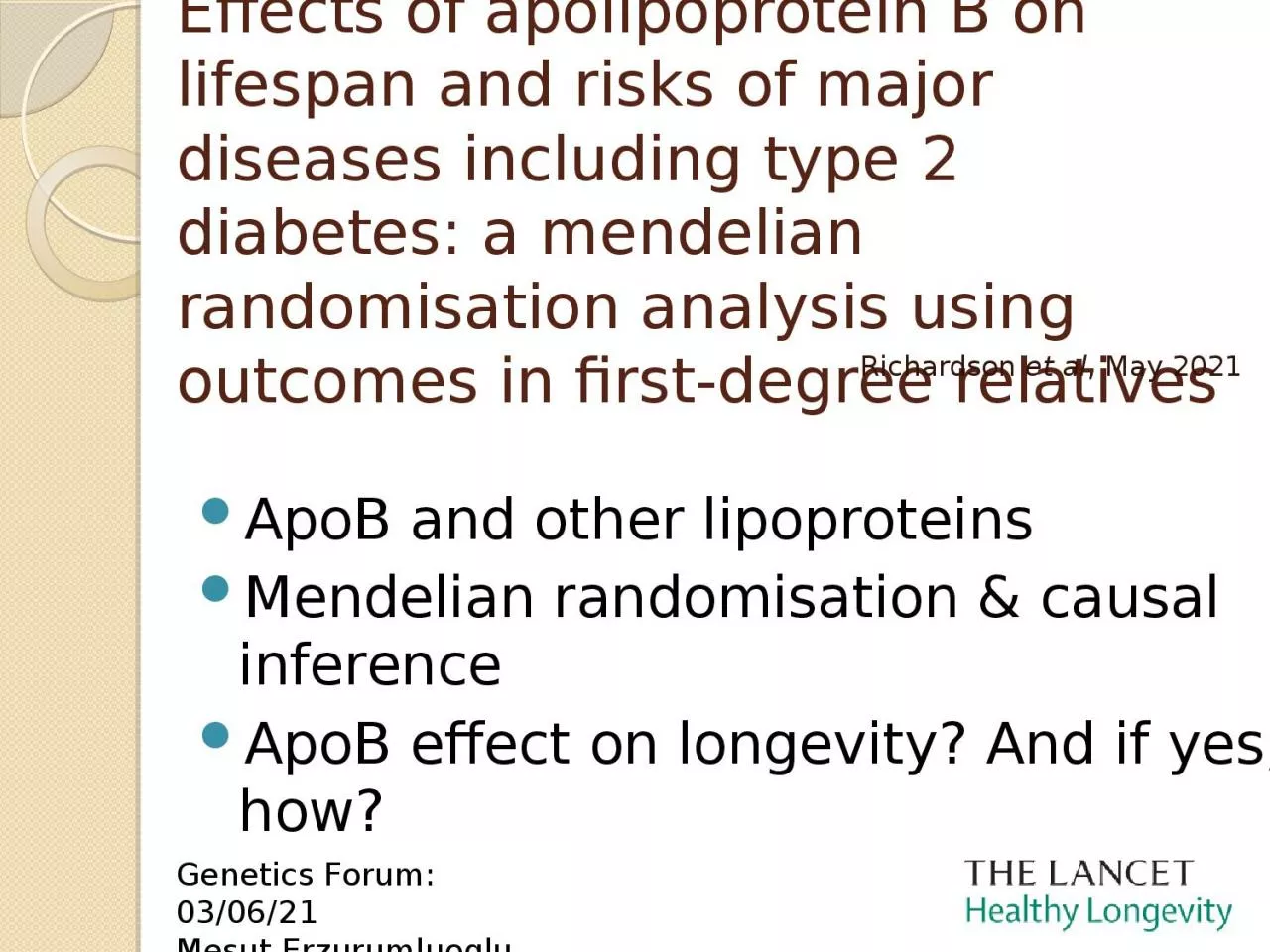

ApoB and other lipoproteins Mendelian randomisation amp causal inference ApoB effect on longevity And if yes how 1 Genetics Forum 030621 Mesut Erzurumluoglu Richardson et al May 2021 ID: 1038321
Download Presentation The PPT/PDF document "Effects of apolipoprotein B on lifespan ..." is the property of its rightful owner. Permission is granted to download and print the materials on this web site for personal, non-commercial use only, and to display it on your personal computer provided you do not modify the materials and that you retain all copyright notices contained in the materials. By downloading content from our website, you accept the terms of this agreement.
1. Effects of apolipoprotein B on lifespan and risks of major diseases including type 2 diabetes: a mendelian randomisation analysis using outcomes in first-degree relativesApoB and other lipoproteinsMendelian randomisation & causal inferenceApoB effect on longevity? And if yes, how?1Genetics Forum: 03/06/21Mesut ErzurumluogluRichardson et al, May 2021
2. 2
3. Causal inference3Observational association Causal or just another correlation?
4. Causal inference in light of large biomarker studies(a Type-2 diabetes example)Many observational associationsCausal or just another correlation?Can’t design a randomised controlled trial? Instrumental variable analysis
5. Mendelian RandomisationUse genetic variants (SNP) as a proxy for the exposure (biomarker)
6. Mendelian randomisation6
7. Reading Mendelian randomisation studies: a guide, glossary, and checklist for clinicians. BMJ 2018
8.
9. Study design
10.
11. Methods38 GWASs in UK BiobankInverse-rank normalisationNon-White Europeans excludedCovariates: age, sex, fasting status, and genotyping chipSoftware: BOLT-LMMLD and distance-based clumping: r²<0.001 and 1MbAssociations between apoB and self-reported outcomes in first-degree relatives were characterised using MR (IVW initially)12 diseases: e.g. heart disease, stroke, and hypertension, Parkinson’s, depression, breast cancerParental vital status (i.e. alive or not) and age at deathReplication in two independent datasets for key novel findings incl. DIAMANTE
12. Effect of elevated ApoB in UKB participants on 1st degree relatives’ disease outcomesInstruments: 229 SNPs associated with ApoB, explaining 10.4% of the heritabilityEffect of ApoB on T2D reversed in MV-MRInstruments: 229 SNPs associated with ApoB, 197 for LDL-C, 411 for Triglycerides
13. Effect of ApoB, Triglycerides and LDL on diseasesInstruments: 229 SNPs associated with ApoB, 197 for LDL-C, 411 for Triglycerides
14. Replication
15. Approximated by MV-MR where LDL-C is increased and ApoB kept constantApproximated by MV-MR analysis when ApoB is increased and LDL-C kept constant
16.
17. Main conclusionsHigher ApoB was associated with a shorter lifespan in parentsLower odds that an individual’s parents were alive and a younger age at their deathInclusion of LDL cholesterol and triglycerides in MV-MR strengthened these effects, suggesting that ApoB is the predominant driving influence on lifespan among these three lipid traits – all replicated using an independent datasetNo of circulating ApoB particles, rather than their lipid content, that is the critical element for atherogenesis, manifested as coronary heart disease and ischaemic strokeApoB should be targeted17
18.
19. 19ReplyQs